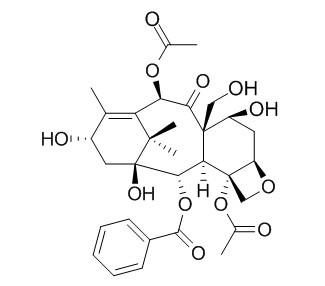19-Hydroxybaccatin III
19-Hydroxybaccatin III, 10-deacetylcephalomannine, and 10-deacetyltaxol are new antitumor taxanes from Taxus wallichiana.
Inquire / Order:
manager@chemfaces.com
Technical Inquiries:
service@chemfaces.com
Tel:
+86-27-84237783
Fax:
+86-27-84254680
Address:
1 Building, No. 83, CheCheng Rd., Wuhan Economic and Technological Development Zone, Wuhan, Hubei 430056, PRC
Providing storage is as stated on the product vial and the vial is kept tightly sealed, the product can be stored for up to
24 months(2-8C).
Wherever possible, you should prepare and use solutions on the same day. However, if you need to make up stock solutions in advance, we recommend that you store the solution as aliquots in tightly sealed vials at -20C. Generally, these will be useable for up to two weeks. Before use, and prior to opening the vial we recommend that you allow your product to equilibrate to room temperature for at least 1 hour.
Need more advice on solubility, usage and handling? Please email to: service@chemfaces.com
The packaging of the product may have turned upside down during transportation, resulting in the natural compounds adhering to the neck or cap of the vial. take the vial out of its packaging and gently shake to let the compounds fall to the bottom of the vial. for liquid products, centrifuge at 200-500 RPM to gather the liquid at the bottom of the vial. try to avoid loss or contamination during handling.
Naunyn Schmiedebergs Arch Pharmacol.2021, 394(1):107-115.
Food Res Int.2020, 133:109130.
Int J Mol Sci.2021, 22(16):8641.
Front Plant Sci.2022, 13:982771.
Molecules.2018, 23(10):E2638
Phytomedicine.2024, 129:155645.
J. ISSAAS2023, 29(2):36-51.
Bull.Natl.Mus.Nat.Sci.,Ser.B.2024, 50(2):79ĘC86
J Vet Sci.2020, 21(3):e39.
Separations2023, 10(4),255.
Related and Featured Products
J Pharmacol Exp Ther. 1989 Mar;248(3):1302-7.
Structure-activity study on the actions of taxol and related taxanes on primary cultures of adrenal medullary cells.[Pubmed:
2564892]
Taxol is a natural plant product which has antimitotic activity. It is currently being investigated for use both as a cancer chemotherapy agent and as a tool to investigate microtubule involvement with various cellular functions.
METHODS AND RESULTS:
In the studies reported here, the actions of taxol on cultured adrenal medullary cells are compared to those of two other taxanes, baccatin III and 19-Hydroxybaccatin III, which are structurally similar but lacking a bulky ester linkage at the C13 position. Unlike taxol, baccatin III and 19-Hydroxybaccatin III have little or no known actions on mammalian microtubules.
CONCLUSIONS:
These studies were designed 1) to establish structural requirements for taxol's effects on adrenal cells and 2) to investigate whether the effects of taxol on adrenal cells involve microtubules. The effects of taxol on basal catecholamine release, on nicotinic receptor-stimulated catecholamine release and on the adrenal microtubule network are quantitatively and qualitatively different from those of baccatin III and 19-Hydroxybaccatin III.
J Nat Prod. 1981 May-Jun;44(3):312-9.
19-Hydroxybaccatin III, 10-deacetylcephalomannine, and 10-deacetyltaxol: new antitumor taxanes from Taxus wallichiana.[Pubmed:
7264680]
METHODS AND RESULTS:
Activity-guided, chromatographic fractionation for a polar extract of Taxus wallichiana Zucc. (originally identified as Cephalotaxus mannii Hook.) resulted in the isolation of three new KB cytotoxic taxane derivatives. Nmr and ms spectral analyses permitted their characterization as 19-Hydroxybaccatin III (3), 10-deacetylcephalomannine (4), and 10-deacetyltaxol (5).
CONCLUSIONS:
The latter two compounds, which are also active against PS leukemia in vivo, were observed to be especially labile, each forming equilibrium mixtures with their cytotoxic C-7 epimers (9, 10).
Chem Pharm Bull (Tokyo). 1995 Feb;43(2):365-7.
Taxol and its related taxoids from the needles of Taxus sumatrana.[Pubmed:
7728941]
METHODS AND RESULTS:
Through bioassay-guided separation of the chemical constituents of the needles of Taxus sumatrana, taxol (1), cephalomannine (2), and a new taxoid 19-hydroxy-13-oxobaccatin III (8) have been isolated together with 7-epi-10-deacetyltaxol (3), 7-epi-10-deacetylcephalomannine (4), baccatin III (5), 19-Hydroxybaccatin III (6), and 10-deacetyl-13-oxobaccatin III (7). The chemical structure of 8 has been elucidated on the bases of its chemical and physicochemical properties.



